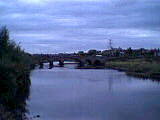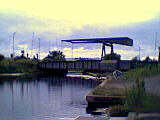|
Below Exeter there were no bridges over the Exe until 1774. Wading was common-place by local who new the river bed and location of the highs and lows. There was a ferry at Topsham. 1772 saw three people and a horse drown after misjudging the tide and flow of the river. Thomas Parker of Topsham was then commisioned by the Exeter Turnpike Trust to build a bridge at Countess Wear.  A seven span bridge was opened in September 1774. The toll gate was on the Exeter side between the bridge and the leat. |
In 1842, Robert Davy who owned a shipbuilding business paid for having one of the middle piers
of the bridge to be removed and to level one of the arches in order to allow his barges better access under the bridge.
This destroyed the symmetry of the bridge which now had three narrow arches on the Matford side of the bridge, the large
centre arch and two others.
 In 1831, James Green (the County Engineer) designed the swing bridge over the canal which allowed passage on the newly extended canal as well as on the road. The Canal Basin in Exeter was being completed at the time. Later road widening schemes saw the swing bridge enlarged into a Bascule bridge, where the bridge floor lifts. |
